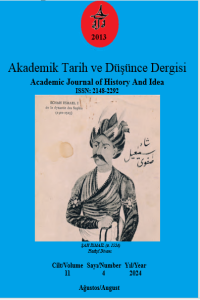An Analysis of Discourse and Its Constitutive Elements within the Framework of Cognitive Linguistics
Öz
This article examines discourse itself, along with its internal elements, namely concept and frame. Initially, the notion of cognitivity and its primary features are discussed, followed by a presentation of various ideas and considerations found in the scientific literature related to discourse, accompanied by expressed attitudes toward these perspectives. Subsequently, the emergence of discourse and its internal elements are studied and analyzed. A concept is characterized as a series of frames that convey the same or similar ideas and imaginations, comprising a nucleus, a perinuclear zone, and a periphery. The nucleus of a concept is typically expressed in language through the initial lexical meanings of root words. A frame is defined as a set of concepts that contribute to the creation of the general meaning of a specific concept along with its nuanced interpretations. The frames forming the perinuclear zone serve as carriers of certain shades of the main idea and are generally expressed in language through grammatical forms and other auxiliary linguistic units. The frames that constitute the periphery of a concept possess the potential to express particular nuances of the main idea at specific moments and are typically represented in language by various linguistic units that manifest in distinct syntactic situations.
Keywords:
Kaynakça
- Asgarov, M. (2015). Theory of Linguo-Psychological Unity. Science and Education, 178-179.
- Askoldov, S. A. (1997). Concept and word. Russian literature. From the theory of literature to the structure of the text. Anthology. Academia, 267-280.
- Demyankov, V. Z. & Kubryakova, Y. S. (1994). Cognitive linguistics as a type of integrating approach. Questions of linguistics. 4. MSU. 31.
- Dessons, G. (2006). Émile Benveniste: l'invention du discours. In Press. 22-23.
- Greimas, J. & Maldidier, D. (1999). On new methods of interpretation, or the problem of meaning from the point of view of discourse analysis. Quadrature of meaning. Progress, 124-136.
- Harris, S. Z. (1952). Discourse Analysis. University of Pennsylvania.
- Kibrik, A. A. & Parshin, P. B. (2001). Discourse. Online Encyclopedia “Around the World”.
- Makarov, M. L. (2013). Fundamentals of discourse theory. ITDGK Gnosis.
- Stepanov, Yu. S. (1995). Alternative world, Discourse, Fact and the principle of Causality. Language and science of the end of the XX century: Collection of articles (Edited by Yu. S. Stepanov). RSUH, 35-73.
An Analysis of Discourse and Its Constitutive Elements within the Framework of Cognitive Linguistics
Öz
This article examines discourse itself, along with its internal elements, namely concept and frame. Initially, the notion of cognitivity and its primary features are discussed, followed by a presentation of various ideas and considerations found in the scientific literature related to discourse, accompanied by expressed attitudes toward these perspectives. Subsequently, the emergence of discourse and its internal elements are studied and analyzed. A concept is characterized as a series of frames that convey the same or similar ideas and imaginations, comprising a nucleus, a perinuclear zone, and a periphery. The nucleus of a concept is typically expressed in language through the initial lexical meanings of root words. A frame is defined as a set of concepts that contribute to the creation of the general meaning of a specific concept along with its nuanced interpretations. The frames forming the perinuclear zone serve as carriers of certain shades of the main idea and are generally expressed in language through grammatical forms and other auxiliary linguistic units. The frames that constitute the periphery of a concept possess the potential to express particular nuances of the main idea at specific moments and are typically represented in language by various linguistic units that manifest in distinct syntactic situations.
Kaynakça
- Asgarov, M. (2015). Theory of Linguo-Psychological Unity. Science and Education, 178-179.
- Askoldov, S. A. (1997). Concept and word. Russian literature. From the theory of literature to the structure of the text. Anthology. Academia, 267-280.
- Demyankov, V. Z. & Kubryakova, Y. S. (1994). Cognitive linguistics as a type of integrating approach. Questions of linguistics. 4. MSU. 31.
- Dessons, G. (2006). Émile Benveniste: l'invention du discours. In Press. 22-23.
- Greimas, J. & Maldidier, D. (1999). On new methods of interpretation, or the problem of meaning from the point of view of discourse analysis. Quadrature of meaning. Progress, 124-136.
- Harris, S. Z. (1952). Discourse Analysis. University of Pennsylvania.
- Kibrik, A. A. & Parshin, P. B. (2001). Discourse. Online Encyclopedia “Around the World”.
- Makarov, M. L. (2013). Fundamentals of discourse theory. ITDGK Gnosis.
- Stepanov, Yu. S. (1995). Alternative world, Discourse, Fact and the principle of Causality. Language and science of the end of the XX century: Collection of articles (Edited by Yu. S. Stepanov). RSUH, 35-73.
Ayrıntılar
| Birincil Dil | Türkçe |
|---|---|
| Konular | Dilbilim (Diğer) |
| Bölüm | Makaleler |
| Yazarlar | |
| Erken Görünüm Tarihi | 4 Ekim 2024 |
| Yayımlanma Tarihi | 22 Eylül 2024 |
| Gönderilme Tarihi | 5 Haziran 2024 |
| Kabul Tarihi | 10 Ağustos 2024 |
| Yayımlandığı Sayı | Yıl 2024 Cilt: 11 Sayı: 4 |
По всем вопросам приема статей и выпуска очередных номеров обращаться в редакцию соответствующего журнала


